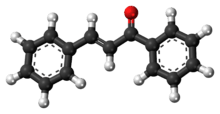Chalcone
 | |
 | |
| Names | |
|---|---|
| Preferred IUPAC name
Chalcone | |
| Systematic IUPAC name
(2E)-1,3-Diphenylprop-2-en-1-one | |
| Other names
Chalkone Benzylideneacetophenone Phenyl styryl ketone | |
| Identifiers | |
| 94-41-7 614-47-1 ((E)-Chalcone) | |
| 3D model (Jmol) | Interactive image |
| ChEBI | CHEBI:27618 |
| ChemSpider | 6921 |
| ECHA InfoCard | 100.002.119 |
| PubChem | 637760 |
| |
| |
| Properties | |
| C15H12O | |
| Molar mass | 208.26 g·mol−1 |
| Density | 1.071 g/cm3 |
| Melting point | 55 to 57 °C (131 to 135 °F; 328 to 330 K) |
| Boiling point | 345 to 348 °C (653 to 658 °F; 618 to 621 K) |
| Except where otherwise noted, data are given for materials in their standard state (at 25 °C [77 °F], 100 kPa). | |
| | |
| Infobox references | |
Chalcone is an aromatic ketone and an enone that forms the central core for a variety of important biological compounds, which are known collectively as chalcones or chalconoids. Benzylideneacetophenone is the parent member of the chalcone series. The alternative name given to chalcone are phenyl styryl ketone, benzalacetophenone, β-phenylacrylophenone, ɣ-oxo-α,ɣ-diphenyl-α-propylene and α-phenyl-β-benzoylethylene.
Chalcones and their derivatives demonstrate wide range of biological activities such as anti-diabetic, anti-neoplastic, anti-hypertensive, anti-retroviral, anti-inflammatory, anti-parasitic, anti-histaminic, anti-malarial, anti-oxidant, anti-fungal, anti-obesity, anti-platelet, anti-tubercular, immunosuppressant, anti-arrhythmic, hypnotic, anti-gout, anxiolytic, anti-spasmodic, anti-nociceptive, hypolipidemic, anti-filarial, anti-angiogenic, anti-protozoal, anti-bacterial, anti-steroidal, cardioprotective, etc.[2][3][4][5]
Chemical properties
Chalcones have two absorption maxima at 280 nm and 340 nm.[6]
Chemical reactions
Synthesis
Chalcones can be prepared by an aldol condensation between benzaldehyde and acetophenone in the presence of sodium hydroxide as a catalyst.
This reaction has been found to work without any solvent at all - a solid-state reaction.[7] The reaction between substituted benzaldehydes and acetophenones can be used as an example of green chemistry in undergraduate education.[8] In a study investigating green syntheses, chalcones were synthesized from the same starting materials in high-temperature water (200 to 350 °C).[9]
Substituted chalcones were also synthesised by piperidine-mediated condensation to avoid side reactions such as multiple condensations, polymerizations, and rearrangements.[10]
Other reactions
An example is the conjugate reduction of the enone by tributyltin hydride:[11]
See also
References
- ↑ Merck Index, 11th Edition, 2028.
- ↑ Mahapatra, Debarshi Kar; Asati, Vivek; Bharti, Sanjay Kumar (2015-03-06). "Chalcones and their therapeutic targets for the management of diabetes: Structural and pharmacological perspectives". European Journal of Medicinal Chemistry. 92: 839–865. doi:10.1016/j.ejmech.2015.01.051.
- ↑ Mahapatra, Debarshi Kar; Bharti, Sanjay Kumar; Asati, Vivek (2015-06-15). "Anti-cancer chalcones: Structural and molecular target perspectives". European Journal of Medicinal Chemistry. 98: 69–114. doi:10.1016/j.ejmech.2015.05.004.
- ↑ Mahapatra, Debarshi Kar; Bharti, Sanjay Kumar; Asati, Vivek (2015-08-28). "Chalcone scaffolds as anti-infective agents: Structural and molecular target perspectives". European Journal of Medicinal Chemistry. 101: 496–524. doi:10.1016/j.ejmech.2015.06.052.
- ↑ Mahapatra, Debarshi Kar; Bharti, Sanjay Kumar (2016-03-01). "Therapeutic potential of chalcones as cardiovascular agents". Life Sciences. 148: 154–172. doi:10.1016/j.lfs.2016.02.048.
- ↑ Photochemistry of chalcone and the application of chalcone-derivatives in photo-alignment layer of liquid crystal display. Dong-mee Song, Kyoung-hoon Jung, Ji-hye Moon and Dong-myung Shin, Optical Materials, 2002, volume 21, pages 667–671, doi:10.1016/S0925-3467(02)00220-3
- ↑ Toda, F., et al., J. Chem. Soc. Perkin Trans. I, 1990, 3207.
- ↑ Palleros, D. R., J. Chem. Educ., 81, 1345 (2004).
- ↑ Comisar, C. M. and Savage, P. E. Green Chem., 6 (2004), 227 - 231. doi:10.1039/b314622g
- ↑ P Venkatesan and S Sumathi, "Piperidine Mediated Synthesis of N-Heterocyclic Chalcones and Their Antibacterial Activity", J. Heterocyclic Chem., 47, 81 (2010).
- ↑ Leusink, A.J.; Noltes, J.G. (1966). "Reaction of organotin hydrides with α,β-unsaturated ketones". Tetrahedron Letters. 7 (20): 2221. doi:10.1016/S0040-4039(00)72405-1.

